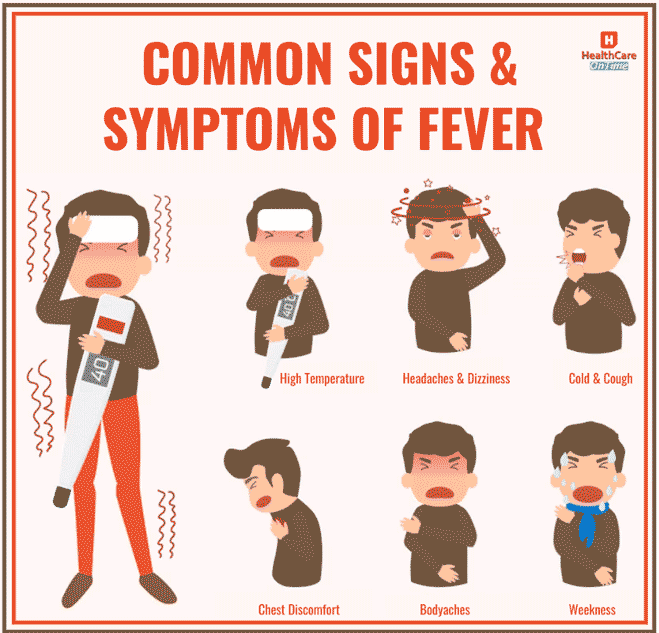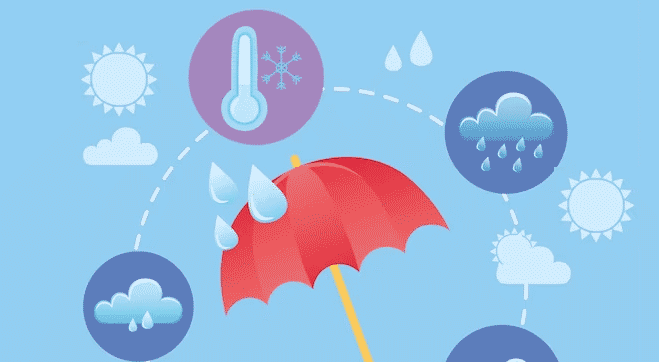Fever (Pyrexia)
Fevers are a widespread health issue in India due to the variety of distinct forms affecting people. For the best possible care, analysis of frequent fever causes, early detection, and prompt treatment are crucial. Although some symptoms might be relieved at home, fevers that persist should be treated by a doctor. People can address concerns about fever in advance and work to maintain their well-being.
The term “fever” medically referred to as pyrexia or hyperthermia, refers to an increase in normal body temperature, which generally hovers around 98.6°F (37°C), the normal body temperature in India.. It means that the body is combating an illness or infection. Fever is a symptom, not an illness, and complications of fever are often present with other illnesses. Fever is a common health risk due to the diverse climate, ecology, and presence of infectious diseases. Normally, the fever gets cured within 3-4 days with proper rest and medications. However, if the fever persists for long, it might indicate a more serious underlying condition that may need further medical attention. Understanding the reason for fever and seeking medical attention accordingly is the key.
What Are Common Signs Of Elevated Body Temperature?

When experiencing an elevated body temperature, also known as fever, individuals might notice several common fever symptoms:
- Feeling Weak
- Eye Pain
- Tiredness
- Shivering and Chills
- Dizziness
- Sweating
- High Temperature
- Loss of Appetite
- Irritation
- Body Aches
- Palpitations
- Headaches
- Muscle and Joint Pain
- Dehydration
Warning:
Extreme caution is warranted when encountering a person with an exceptionally high fever, defined as a temperature surpassing 104°F. This level of fever can lead to alarming complications, including:
- Hallucinations: Distorted perceptions of reality.
- Convulsions: Sudden, uncontrolled movements.
- Confusion: Mental disarray and uncertainty.
Alert: COVID-19 Suspicions
If an individual is grappling with a fever accompanied by a dry cough, they could be exhibiting symptoms of COVID-19. Furthermore, watch out for other prevalent signs such as:Shortness of Breath and Fatigue
What Are Considered Continuous Fever Causes?
You may observe an elevation in your body temperature due to a host of reasons, but some major fever causes are mentioned below:
- Bacterial, viral and fungal infections
- Exhaustion due to extreme heat
- Inflammatory conditions – rheumatoid arthritis, lupus or inflammatory bowel syndrome (IBS)
- Hyperthyroidism and other hormonal disorders
- Types of cancer
- Certain OTC medications
- Blood clots
- Coronavirus Disease (COVID-19)
- Food poisoning
Did you know:
Fever intensifies at night due to lowered cortisol levels, weakening our defense system as body functions slow down during nighttime.
What Are The Types of Fevers That Indians Suffer From?
India’s diverse geography includes areas with both warm and cold climates. Indians are hence prone to different types of fevers with numerous versatile instances where fever comes and goes.
Major Fever Types In India Include:
- Malaria Fever: Malaria is predominantly known to be caused by the Plasmodium Parasite. It is a significant concern in certain parts of India with high humidity and rain. Muscle aches, high fever, chills, headaches, and tiredness are some of the key symptoms of malaria among others.
- Dengue: It is one of the most prominent monsoon diseases. The mosquito-borne dengue virus in India has become a major public health problem. The dengue virus causes the sickness and is transmitted through an Aedes mosquito bite. Dengue fever symptoms include sudden fever without cold and cough, intense headache, and skin rashes.
- Leptospirosis: It is a bacterial infection, the disease spreads to people when they come in contact with water or soil that’s been contaminated by an infected animal’s urine. Symptoms of leptospirosis include high fever, headache, vomiting, muscle pain, chills, and yellowish skin (jaundice), among others.
- Typhoid: Typhoid fever is a bacterial infection caused by the bacterium Salmonella Typhi. It spreads primarily through contaminated food and water. Common symptoms include high fever, stomach pain, headache, and a rash known as “rose spots.” Typhoid can be serious and requires proper medical treatment, including antibiotics.
- Chikungunya: Chikungunya is a viral disease transmitted through the bite of infected mosquitoes, particularly the Aedes species. It leads to symptoms such as high fever, severe joint pain, muscle pain, headache, and rash. While rarely fatal, Chikungunya can cause long-lasting joint pain and fatigue.
Based On The Causes Of Fever, The Key Fever Variants Are:
- Viral Fever: Airborne viruses are the key agents that lead to viral fever. People of all ages are susceptible to this type of fever and may have symptoms, such as nausea, vomiting, an upset stomach, diarrhoea along with fever. Your healthcare provider may recommend some OTC medications to relieve the symptoms as antibiotics fail to work for such fevers.
- Bacterial Fever: From the central nervous system to respiratory, gastrointestinal, circulatory system, kidneys and skin are all susceptible to developing a versatile range of bacterial infections. Detecting the symptoms and administering the appropriate antibiotics based on the organ affected can help relieve bacterial fever symptoms.
- Fungal Fever: Fungal agents can impact most of our organs and lead to fever. Your healthcare provider will assess the severity of your symptoms and recommend antifungal medications accordingly.
The other types of fever include:
- Animal exposure fever – Bacterial contamination while working with livestock can cause headache, muscle and joint pain, fever and chills.
- Traveller’s fever – Some people tend to get infected when exposed to a new location, setting, food, weather and other environmental aspects. Antibiotics should be administered to treat this fever to avoid it from worsening.
- Blood clot fever – A blood clot in the calf blood vessels may rupture and travel to the lungs through the bloodstream and cause inflammation-led fever too.
- Drug fever – You might develop fever as a reaction to certain medications. Mostly with the discontinuation of the medication, fever goes away. However, if you are experiencing any allergic reaction, do consult your doctor right away.
Based On The Duration, Key Fever Types Include:
- Acute Fever – A sudden and short-term increase in body temperature, which is more than 100.4 degree Fahrenheit, is deemed as acute fever. It may happen due to a flu, cold, cough, pneumonia or other health conditions. If left untreated for long, it may lead to serious health complications.
- Subacute Fever – Autoimmune diseases and certain types of cancers may lead to inflammation in the body, which keeps the body temperature elevated, ranging from a few days to a few weeks. If you observe any other symptoms along with a low-grade and persistent fever, do consult with your doctor right away.
- Recurrent Fever – Also known as “Periodic Fever Syndromes”, this is a type of fever that comes and goes in a repetitive pattern and is often caused due to autoimmune conditions, infections, tuberculosis, Lyme disease, periodic fever, aphthous stomatitis, pharyngitis and adenitis (PFAPA) syndrome, etc. Your healthcare provider can recommend at-home blood tests and imaging tests to determine the exact cause and treatment measures.
- Intermittent Fever- This type of fever is characterised by periods of normal body temperature followed by elevated temperature levels. Seek accurate diagnosis and treatment if your fever is caused by any autoimmune condition, rickettsial infections, malaria and other cancerous conditions.
- Remittent Fever– Also know as “Continuing Fever” involves fluctuating temperature levels without returning to normal. Monitoring and medical guidance are essential for managing this condition effectively.
- Hyperpyrexia – A body temperature more than 106 degree Fahrenheit is considered a high-grade fever, which is often caused by a chronic health condition. This type of fever needs prompt medical attention; otherwise, it may lead to severe dehydration and organ damage.
- Relapsing Fever – Mostly caused by the Borella bacteria that are transmitted through insect or lice bites, relapsing fever can lead to acute headaches, muscle and joint soreness and skin rashes. Antibiotics are usually administered to prevent further complications.
- Septic Fever – Also referred to as sepsis, this type of fever usually occurs due to an acute infection or inflammation in the body. Antibiotics and allied care must be sought after promptly to prevent life-threatening complications.
- Idiopathic Fever – For this variant of fever, there is no explaining cause or medical condition. While this may go away on its own within a few days, periodic health checkups are recommended to identify and reassess underlying health conditions.
When To Seek Medical Attention For Fever?
Fevers are generally manageable, but specific situations warrant medical attention for you or your loved ones. Here’s when to consult a doctor based on different age groups:
For Infants and Toddlers:
- If your baby is under 3 months old and has a rectal temperature of 100.4°F (38°C) or higher.
- For ages 3 to 6 months, with a rectal temperature above 102°F (38.9°C), or if they seem unusually irritable, sluggish, or uncomfortable.
- Between 7 and 24 months old, with a rectal temperature exceeding 102°F (38.9°C) lasting more than one day, but without other symptoms. If other symptoms like a runny nose, cough, or diarrhea are present, consider calling sooner.
For Children:
- Your child appears unusually lethargic, confused, or struggles with maintaining eye contact.
- They experience recurring vomiting, severe headaches, a sore throat, stomachache, or intense discomfort.
- The fever persists for over three days.
For Adults:
Contact your healthcare provider if your temperature reaches 103°F (39.4°C) or higher. Seek immediate medical help if any of these symptoms accompany the fever:
- Confusion, altered speech, or unusual behavior
- Rash
- Persistent vomiting
- Convulsions or seizures
- Abdominal pain
- Severe headache
- Difficulty breathing or chest pain
- Painful urination
- Increased sensitivity to light
- Stiff neck and head-bending pain
Accurate Fever Diagnosis
When people experience a high fever with chills or the fever is accompanied by other disturbing symptoms, diagnosis becomes essential to determine the underlying reason and begin the proper therapy. The crucial tests listed below are useful for accurate fever diagnosis.
- Fever Profile Test: The fever profile test is a comprehensive blood test that helps identify the exact causes of fever. A complete blood count (CBC) is part of the checkup and helps identify any infections or other irregularities.
Explore our tailored options at HealthcareOnTime for fever profile testing
- Fever Blood Test – Basic (Includes- 28 Parameters)
- Fever Blood Test – Comprehensive (Includes- 34 Parameters)
- Fever Blood Test – Advance (Includes- 36 Parameters)
- Malaria Parasite Test: An evening rise in temperature causes severe doubts. A test using a blood strip is used to identify malaria by determining if the red blood cells contain Plasmodium parasites. There are also rapid Diagnostic Test (RDTs) for quickly identifying malaria antigens in case of remittent fever.
- Malaria Antigen Test: The malaria antigen test is a simple diagnostic method that quickly determines whether there are antigens of malaria present in a person’s blood so that they can receive immediate treatment.
- Leptospira IgM Test: The Leptospira IgM test is a diagnostic procedure that looks for a reason for frequent fever and a buildup of IgM antibodies, which indicates recent Leptospira infections caused by bacteria.
- Dengue NS1 Antigen Test: The NS1 antigen of the dengue virus can be found in the blood during the early stages of fever, in case of fever with no other symptoms, using a quick test called the dengue NS1 antigen test.
Does Sweating Mean a Fever is Breaking?
Sweating during a fever often raises questions about its significance in relation to the fever’s progression. While sweating can occur as a fever subsides, it doesn’t necessarily indicate that the fever is breaking definitively.
Sweating is part of the body’s natural response to regulate temperature. As the fever-inducing agent, such as an infection, is brought under control, the body may attempt to cool down through sweating. This can be accompanied by a drop in body temperature, leading some to believe the fever is breaking. However, it’s important to understand that fever patterns vary, and sweating alone isn’t a conclusive sign of recovery.
Monitoring other symptoms alongside sweating is essential. If the underlying cause of the fever persists, the body may experience fluctuations in temperature, including moments of sweating followed by fever recurrence. Consulting a medical professional is advisable for a comprehensive assessment of your condition.
while sweating can coincide with a decrease in body temperature, it doesn’t unequivocally indicate the fever is breaking. The fever’s course should be evaluated holistically, with consideration of various symptoms and medical advice to determine the accurate state of your health.
Home Remedies for Fever
Frequent home remedies for fever treatment are easy and help you breaking down fever. It is imperative to remember that these treatments are just meant to be supportive and should not be used in place of professional medical advice. Let’s explore how to reduce fever at home:
- Rest: To help the body fight off the infection and conserve energy, make sure you get enough sleep. It comes under effective Indian home remedies for fever.
- Hydration: Drinking plenty of water when you have a fever is important to prevent dehydration caused by fluid loss.
- Cooling Measures: Apply cool compresses to the body or take a warm bath to help lower your body’s temperature in case of continuous fever.
Note From HealthcareOnTime
It is crucial to make an accurate and timely diagnosis regarding the reason for fever while treating fevers to ensure the right course of treatment. HealthcareOnTime offers at-home testing in collaboration with Thyrocare that can aid in the early recognition and diagnosis of a number of fevers.
HealthcareOnTime helps people to take charge of their health and, if necessary, seek timely medical care by providing the convenience of at-home testing. Reduced fever-related issues can lead to better health outcomes when they are identified early and treated effectively.
Sources
Ref Links:
- https://www.cdc.gov/parasites/malaria/index.html
- https://www.who.int/news-room/questions-and-answers/item/dengue
- https://my.clevelandclinic.org/health/diseases/24021-leptospirosis
- https://en.wikipedia.org/wiki/Malaria_antigen_detection_tests
- https://www.metropolisindia.com/parameter/dengue-ns1-antigen-test











